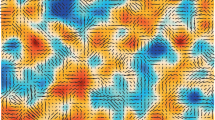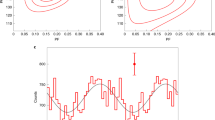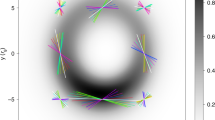Abstract
Measurements of the cosmic microwave background (CMB) radiation can reveal with remarkable precision the conditions of the Universe when it was ∼400,000 years old. The three most fundamental properties of the CMB are its frequency spectrum (which determines the temperature), and the fluctuations in both the temperature and polarization across a range of angular scales. The frequency spectrum has been well determined, and considerable progress has been made in measuring the power spectrum of the temperature fluctuations. But despite many efforts to measure the polarization, detection of this property of the CMB has hitherto been beyond the reach of even the most sensitive observations. Here we describe the Degree Angular Scale Interferometer (DASI), an array of radio telescopes, which for the past two years has conducted polarization-sensitive observations of the CMB from the Amundsen–Scott South Pole research station.
This is a preview of subscription content, access via your institution
Access options
Subscribe to this journal
Receive 51 print issues and online access
$199.00 per year
only $3.90 per issue
Buy this article
- Purchase on Springer Link
- Instant access to full article PDF
Prices may be subject to local taxes which are calculated during checkout








Similar content being viewed by others
References
Leitch, E. M. et al. Experiment design and first season observations with the Degree Angular Scale Interferometer. Astrophys. J. 568, 28–37 (2002)
Halverson, N. W. et al. Degree Angular Scale Interferometer first results: A measurement of the cosmic microwave background angular power spectrum. Astrophys. J. 568, 38–45 (2002)
Pryke, C. et al. Cosmological parameter extraction from the first season of observations with the Degree Angular Scale Interferometer. Astrophys. J. 568, 46–51 (2002)
Kovac, J. M. et al. Detection of polarization in the cosmic microwave background using DASI. Nature 420, 772–787 (2002)
Padin, S. et al. The Cosmic Background Imager. Publ. Astron. Soc. Pacif. 114, 83–97 (2002)
Kamionkowski, M., Kosowsky, A. & Stebbins, A. Statistics of cosmic microwave background polarization. Phys. Rev. D 55, 7368–7388 (1997)
Zaldarriaga, M. & Seljak, U. All-sky analysis of polarization in the microwave background. Phys. Rev. D 55, 1830–1840 (1997)
Hu, W. & White, M. A CMB polarization primer. New Astron. 2, 323–344 (1997)
Moffat, P. H. Aperture synthesis polarimetry of the moon at 21 cm. Mon. Not. R. Astron. Soc. 160, 139–154 (1972)
Mitchell, D. I. & De Pater, I. Microwave imaging of Mercury's thermal emission at wavelengths from 0.3 to 20.5 cm. Icarus 110, 2–32 (1994)
Poppi, S., Carretti, E., Cortiglioni, S., Krotikov, V. D. & Vinyajkin, E. N. AIP Conf. Proc. 609, Astrophysical Polarized Backgrounds (eds Cecchini, S., Cortiglioni, S., Sault, R. & Sbarra, C.) 187–192 (AIP, Melville, New York, 2002)
Burton, M. G. et al. High-resolution imaging of photodissociation regions in NGC 6334. Astrophys. J. 542, 359–366 (2000)
Jackson, J. M. & Kraemer, K. E. Photodissociation regions and HII regions in NGC 6334. Astrophys. J. 512, 260–270 (1999)
Högbom, J. A. Aperture synthesis with a non-regular distribution of interferometer baselines. Astron. Astrophys. Suppl. 15, 417–426 (1974)
Haslam, C. G. T. et al. A 408 MHz all-sky continuum survey. I—observations at southern declinations and for the north polar region. Astron. Astrophys. 100, 209–219 (1981)
Padin, S., Cartwright, J. K., Shepherd, M. C., Yamasaki, J. K. & Holzapfel, W. L. A wideband analog correlator for microwave background observation. IEEE Trans. Instrum. Meas. 50, 1234–1240 (2001)
Wright, A. E., Griffith, M. R., Burke, B. F. & Ekers, R. D. The Parkes-MIT-NRAO (PMN) surveys. 2: Source catalog for the southern survey (- 87.5° < δ < -37°). Astrophys J. Suppl. 91, 111–308 (1994)
Acknowledgements
We are indebted to the Caltech CBI team led by T. Readhead, in particular to S. Padin for a considerable fraction of DASI's electronics design, to J. Cartwright for the downconverter design and to M. Shepherd for data acquisition software. E. Chauvin of Vertex/RSI is thanked for professional excellence in the design and delivery of the telescope mount. We thank Raytheon Polar Services for their support of the DASI project, including the erection of the DASI ground shields, and in particular R. Rowatt and his crew. We are indebted to the Center for Astrophysical Research in Antarctica (CARA), in particular the efforts of A. Day, S. Meyer, N. Odalen, R., D. and E. Pernic, R. Lowenstein, R. Spotz, M. Whitehead and the CARA polar operations staff. We thank J. Kooi for his assistance with the installation of the polarization hardware, J. Yamasaki for help with electronics, E. LaRue and G. Drag for the assembly of the calibration wire grids, M. Loh for assistance with the Sun shield and K. Coble for analysis of DASI primary beam measurements. We thank the TopHat collaboration for the use of their Sun shield. We thank the observatory staff of the Australia Telescope Compact Array, in particular B. Sault and R. Subrahmanyan, for their generosity in providing point source observations of the DASI fields. This research was initially supported by the National Science Foundation (NSF) under a cooperative agreement with CARA, a NSF Science and Technology Center; it is currently supported by the NSF-OPP. J.E.C. acknowledges support from the James S. McDonnell Foundation and the David and Lucile Packard Foundation. J.E.C. and C.P. acknowledge support from the Center for Cosmological Physics.
Author information
Authors and Affiliations
Corresponding author
Ethics declarations
Competing interests
The authors declare that they have no competing financial interests.
Rights and permissions
About this article
Cite this article
Leitch, E., Kovac, J., Pryke, C. et al. Measurement of polarization with the Degree Angular Scale Interferometer. Nature 420, 763–771 (2002). https://doi.org/10.1038/nature01271
Received:
Accepted:
Issue Date:
DOI: https://doi.org/10.1038/nature01271
This article is cited by
-
The Physical Foundation of Quantum Theory
Foundations of Physics (2023)
-
Reconstruction of full sky CMB E and B modes spectra removing E-to-B leakage from partial sky using deep learning
Journal of Astrophysics and Astronomy (2023)
-
Fabrication and Characterization of Superconducting Bilayer (Al/Ti) Transition-Edge Sensor Bolometer Array
Journal of Electronic Materials (2019)
-
Digital complex correlator for a C-band polarimetry survey
Experimental Astronomy (2011)
-
Astronomy in Antarctica
The Astronomy and Astrophysics Review (2010)
Comments
By submitting a comment you agree to abide by our Terms and Community Guidelines. If you find something abusive or that does not comply with our terms or guidelines please flag it as inappropriate.



